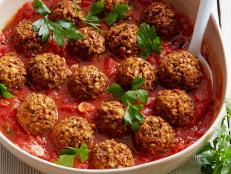How To Put Together a Balanced, Fully Plant-Based Plate
Vegetables are a crucial part of any balanced plate, but they shouldn’t be the only foods on it. Here are the proportions full- and part-time plant-based eaters should keep in mind.

Photo courtesy of Ashley Lima
Are you following a plant-based diet? Plant-based means eating mainly or all plant foods, depending on an individual’s needs and preferences. Someone who is plant-based may fill their plate with mostly plants and include smaller portions of animal products like meat, milk and dairy, fish or eggs. Someone who is fully plant-based may identify as a vegan. Everyone can choose the basis of their foods, but balancing food properly on the plate is essential to good health. As a registered dietitian and author of new cookbook Up Your Veggies: Flexitarian Recipes for the Whole Family, it’s clear to me that while it’s important to have a robust amount of vegetables on your plate, they shouldn’t be the only foods on your plate. If you choose to only eat plants, then your meal needs to be balanced with a variety of plant-based foods to ensure that you’re taking in essential nutrients from carbohydrates, proteins, fats, vitamins and minerals. Here’s how to make sure your plate is balanced if you choose to be 100-percent plant-based.
The first thing to pay attention to is portion management, which means choosing a plate size that is right for you. For those targeting a daily 1,800-to-2,000-calorie goal, an eight-inch plate is a good place to start – you’ll get a meal that adds up to roughly 450 to 550 calories. If you need more calories, you can opt for a nine-inch plate; if you need fewer calories, go for a seven-inch plate.
Next, divide your plate into three sections: half your plate, and two quarters. Half your plate should be filled up with fruits and vegetables. They can be fresh, canned, frozen or dried. One quarter of your plate should be starches which can come from starchy vegetables like potatoes, yams and corn or from grains — especially whole grains — like brown rice, farro, quinoa and barley. The last quarter of your plate should be filled with protein. For 100-percent plant-based plates, protein options can include tofu, beans, chickpeas, seitan, lentils and nut butter.
The last part of the plate should be milk or dairy, but on a 100-percent plant-based plate, it should be soy milk, which is the closest composition to cow’s milk in terms of the vast array of nutrients it provides. The 2020-2025 dietary guidelines for Americans specifically calls out soy milk and soy yogurt as substitutes for cow’s milk – and no other plant-based beverage. If you choose almond, hemp, oat or other plant-based beverages, then enjoy them for their calcium, and sometimes vitamin D and protein, but note that they do not count as sufficient nutritional substitutes for the milk and dairy group.
Finally, don’t forget to include a healthy fat. Avocado, olives, vinaigrettes made with oil, and even extra-virgin olive oil drizzled on vegetables, are ways to increase your healthy fats during a meal.
Need some inspiration? Try this vegetable and farro bowl recipe.
Brussels Sprouts, Kale and Farro Bowl
This recipe is packed with everything I want from a bowl; a hearty base, tons of veggies and a nice crunchy finish.
Serves: 4
Serving size: 1 bowl
INGREDIENTS:
1 cup farro
2 cups water
1 cup low-sodium vegetable broth
1 lb Brussels sprouts, halved
1 lb butternut squash, cubed
3 Tbsp olive oil, divided
2 Tbsp liquid honey
1/4 tsp + 1/8 tsp salt, divided
6 cups chopped kale
2 medium carrots, shredded
1/8 tsp ground black pepper
1/4 cup chopped walnuts
1/4 cup crumbled goat cheese (optional)
DIRECTIONS:
- Line a rimmed baking sheet with parchment paper or a silicone mat.
- Preheat the oven to 425 degrees F.
- In a medium saucepan, combine the farro, water and vegetable broth; bring to a boil over high heat. Reduce the heat to medium-low, cover and simmer until the farro is cooked through, about 30 minutes. Fluff with a fork and set aside to cool slightly.
- In a large bowl, combine the Brussels sprouts, squash, 2 tbsp olive oil, honey and 1/4 tsp salt. Spread the mixture on the prepared baking sheet in a single layer.
- Place the baking sheet in the preheated oven and roast the vegetables, turning halfway through, until they begin to brown, about 25 minutes. Remove the baking sheet from the oven and set aside to cool slightly, about 5 minutes.
- In a large skillet, heat the remaining 1 tbsp olive oil over medium heat until shimmering. Add the kale, carrots, pepper and remaining 1/8 tsp salt; cook until the kale has wilted and carrots have softened, about 3 minutes.
- In each of 4 bowls, arrange 1/4 cup cooked farro and 1-1/2 cups roasted vegetable mixture side by side. Top with about 1/2 cup carrot-kale mixture. Sprinkle with 1 tbsp each of the walnuts and goat cheese (if desired). Serve warm.
Nutrition Info (per serving): Calories: 468; Total Fat: 19g; Saturated Fat: 3g; Protein: 16g; Total Carbohydrates: 66g; Fiber: 14g; Sugars: 14g; Sodium: 397mg; Cholesterol: 4mg.
Recipe from Up Your Veggies: Flexitarian Recipes for the Whole Family by Toby Amidor. Published by Robert Rose Books. Photo courtesy of Ashley Lima. All Rights Reserved.
Related Content:

































